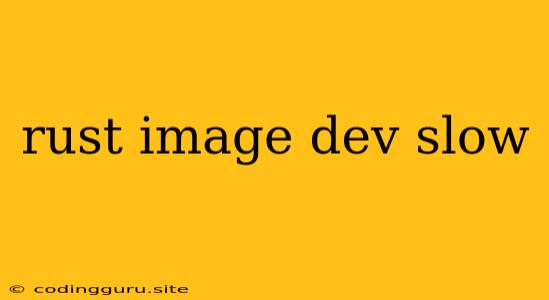Why is Rust Image Development So Slow?
Rust is a powerful and efficient language, but its development process can sometimes feel slow, especially when it comes to image manipulation. This is due to a combination of factors, including:
- Image processing libraries: The Rust ecosystem has several image processing libraries, but many are still under development and lack the maturity and extensive feature set of libraries in other languages. This means that you may need to spend more time searching for the right library, debugging issues, and implementing features yourself.
- Compilation times: Rust is a compiled language, and its compilation process can be time-consuming, especially for larger projects. This is exacerbated when working with images, which often require a significant amount of code and data.
- Learning curve: While Rust is a relatively safe and predictable language, its ownership system and strict borrowing rules can be challenging for newcomers, leading to slower development cycles.
Here's a breakdown of how these factors contribute to slow development:
Image Processing Libraries
Why are they so important? Image processing libraries are essential tools for developers who need to manipulate, analyze, and generate images.
What are the challenges?
- Limited Feature Set: While libraries like image and image-rs provide good fundamental image manipulation functionality, they may not offer the advanced features you need for specific tasks like image filtering, edge detection, or object recognition.
- Lack of Maturity: Some libraries are still in active development, which can mean frequent updates, breaking changes, and unstable APIs. This can hinder your development progress as you might need to adapt your code constantly.
- Limited Documentation: Adequate documentation is crucial for understanding a library's capabilities and how to use it effectively. Limited or incomplete documentation can slow down development as you might spend more time figuring out how to use the library.
Compilation Times
What makes Rust compilation so slow?
Rust's compile times are often longer compared to other languages like Python or JavaScript. This is due to its:
- Strict type system: Rust's strong type system, while beneficial for code safety, adds overhead to the compilation process as the compiler needs to verify all types and their interactions.
- Complex macros: Macros are powerful tools that allow you to generate code dynamically, but they can also increase compilation times.
- Extensive optimizations: The Rust compiler performs extensive optimizations to produce highly efficient code, which takes time.
How does this impact image development?
When working with images, you might deal with large datasets and complex algorithms. This can lead to significantly longer compilation times, hindering your development cycle, as you need to wait longer for code changes to be reflected.
Learning Curve
What makes Rust's learning curve steep?
- Ownership and Borrowing: Rust's ownership and borrowing rules are designed to ensure memory safety but can be challenging to grasp initially. It often requires a paradigm shift in how you think about managing memory and data access.
- Error handling: Rust uses a strict error handling system with the Result type, which can be unfamiliar to developers coming from other languages.
- Cargo (Build system): While Cargo is a powerful and convenient build system, it requires a learning curve to understand its configuration, dependencies, and various features.
How does this affect image development?
Learning Rust's unique features and concepts takes time and effort. This can slow down your development, especially when you need to work with complex image processing tasks that require advanced Rust features.
Tips for Faster Rust Image Development
Here are some tips to combat these challenges:
- Choose the right libraries: Thoroughly research available libraries and prioritize mature, well-documented options. Consider the specific tasks you need to accomplish and select a library that offers the best balance of features, performance, and stability.
- Optimize compilation times:
- Use Cargo features: Leverage Cargo's features like features, profiles, and workspace to efficiently manage your projects and dependencies, potentially reducing compilation times.
- Enable incremental compilation: Use
cargo build --incrementalto instruct Cargo to compile only the changed parts of your code, saving time for smaller changes. - Reduce unnecessary dependencies: Keep your dependencies minimal to reduce the overall compilation workload.
- Embrace the Rust ecosystem: Participate in the Rust community, explore forums, and seek help when facing challenges. You can learn valuable tips and tricks from experienced Rust developers, improving your efficiency and development speed.
Conclusion
While Rust image development can be initially slower, it's important to remember the long-term benefits. Rust's performance, safety, and robust ecosystem make it a powerful choice for image processing. By understanding the challenges and implementing the tips discussed above, you can mitigate the slowness and maximize your development efficiency in Rust.
